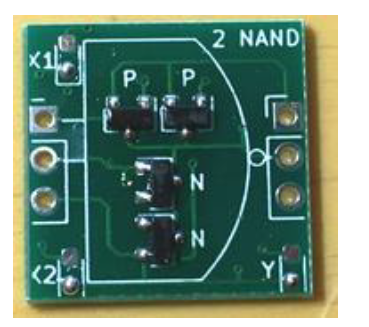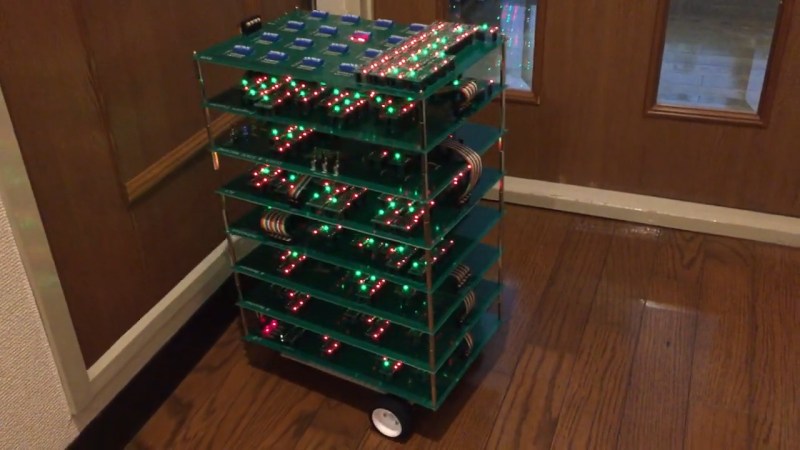What do you get when you stick 1738 MOSFETs together? If your answer was a ‘4-bit CPU’, you would be totally correct. Available as a product over at Marutsu as the ‘CPU1738’, it seems to target beginners to computer theory, with build instructions that explain how the CPU is built up from individual MOSFETs that are combined into logic gates.

While decidedly more compact in its SMD format than it would have been with pure through-hole parts, the use of countless small PCBs on top of the larger PCBs make for a pretty hefty package. Board after board build up the CPU, and the assembly continues with the addition of sensors, motors, and wheels. In the end, a robot emerges, albeit a somewhat wobbly-looking one.
Check out the video linked after the break, though before starting one up, note the 50,000 Yen (approximately $500) price tag for the CPU block alone. On the other hand, in addition to the 1738 MOSFETs, there are also 1070 LEDs, so you get what you pay for in blinkies.
















Best Christmas Tree Ever.
It could be furher developed into automatic toilet seat. Lovely blinkenlights when it senses occupancy and self-closes after use.
I have nothing to declare except this is brilliant and I tip my cap in the creator’s direction. Great work.
Needs some plexiglass panels (adds to rigidity and as a bonus leds reflecting in the structure would make it even more blink) and a cupholder (“bring me beer / soda”) otherwise great project and i wish i could afford one / justify it at 500 bucks.
Unfortunately, 500$ plus a cup holder just gets you an end table with blinky potential. That doesn’t include the “rover” portion, and you have to program the “blinky”. :)
“While decidedly more compact in its SMD format than it would have been with pure through-hole parts,”
It looks like the PCB’s would accommodate 4 TO92 FETs with ease. Laying them flat would increase the height only by a few mm.
Years ago I picked up a spool of cheap NPN transistors with the crazy dream of making a discrete ECL computer with it. Then life got in the way. So, I salute this design. Well done!
it seems i’m not the only one then.
Would you share your experiments, if any ?
I did some logs at https://hackaday.io/project/13409-germanium-ecl/log/178057-low-voltage-ecl-part-1 and others
Nowhere near as far as you did. I started the project in college over two decades ago and didn’t keep good notes. It was an extension of a project I did for a class where I did a survey of switching speed for a variety of 74 series logic families (3 and 5 inverter ring oscillators). The hardest part of the project ended up being sourcing all of the (even then) obscure 74 series families: L, LS, H, C, L, S, AS, ALC, HC, HCT, etc. I was thinking of extending it to the different ECL families–Motorola has just extended their ECLips family of super fast discrete ECL. I was curious what I could do with discrete parts.
As you seem to have discovered as well, RTL and DTL have a lot of drawbakcs and aren’t easier to use than ECL (and having the option of every signal being differential gives free inversion). But school got in the way. Later, when money wasn’t as much of an issue, I picked up the transistors (house marked equivalents to the 2n4401) But, by that time, work and other time demands got on in the way. Then a family… I only remember the project from time to time when I’m cleaning my office and I come over the spool of transistors.
You should definitely document that, and/or join our group of TTLers :-)
It feels less lonely when others share their similar scratch-itchings ;-)
They’re on sale again! 1000 2n4401 or similar for $6. Must control urge to buy more….
https://www.bgmicro.com/9Z2016.aspx
ooooops I hit the wrong button /o\
PLEASE document before you buy !
It’s easy to buy parts that will collect dust in your drawers.
And with 1K transistors, what would you do ? that’s pretty short for even a simple processor, I think you’d need at least 3K or 4K to get something remotely useful.
I don’t consider purchasing parts if there are fewer than 3K available, that’s a full reel, two or three is better ! So if you want to get near anything workable, that’s already $60 spent, even before you know what you design.
If you want to go ahead anyway, have a look at Tim’s latest works :-)
https://hackaday.io/project/176107-led-coupled-logic-lcl
Replace the LED with 3 diodes in series and you’re good.